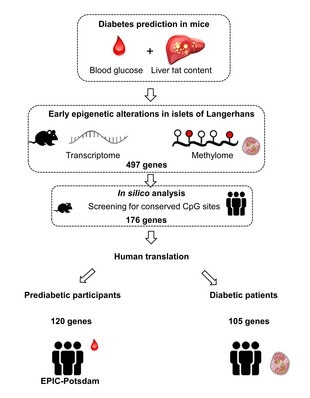Scientists can detect epigenetic changes in the islets of Langerhans of the pancreas in patients several years before these individuals are diagnosed with type 2 diabetes.

The researchers first identified early changes in DNA methylations and the expression patterns in the islets of Langerhans in diabetes-prone mice and then investigated which of these could be identified in humans before diabetes was diagnosed. Image Credit: German Institute of Human Nutrition (DIfE).
Such modifications are responsible for the altered methylation activity of particular genes, which is different from the methylation activity in healthy people.
In total, 105 such mutations have been identified in the blood cells of humans. This was demonstrated in a research work performed by scientists from the German Center for Diabetes Research and the German Institute of Human Nutrition, which was recently published in the Diabetes journal. These results could help design diagnostic markers for type 2 diabetes.
Many factors play a crucial role in the development of type 2 diabetes. These comprise epigenetic factors, a genetic predisposition, and also a high-fat, high-sugar diet, lack of exercise, and overweight.
Hence, to avoid the development of the metabolic disease, people with a higher risk for the metabolic disease should be identified at an early phase.
Since the onset of diabetes can also cause functional disorders in the islets of Langerhans in the pancreas, scientists from the German Institute of Human Nutrition and the German Center for Diabetes Research have analyzed whether there are epigenetic variations in the islets of Langerhans that are also associated with the onset of diabetes. The study also involved Lund University.
Our aim was to identify early changes in DNA methylation and the expression pattern in the islets of Langerhans in a diabetes-prone mouse and then to test which of these can also be detected in the blood of humans before diabetes is diagnosed.”
Dr Annette Schürmann, Professor and Spokesperson, German Center for Diabetes Research
Schürmann, who explained the translational research approach, is also the head of the Department of Experimental Diabetology at the German Institute of Human Nutrition.
For this purpose, obese mice were given a high-calorie diet for a period of five weeks and later split into diabetes-resistant and diabetes-prone animals based on certain criteria (for example, the fat content in the liver). Within the islets of Langerhans, the DNA methylations and expression patterns were established for both groups.
We were able to identify 497 candidates which differed both in terms of their expression and their DNA methylation.”
Dr Meriem Ouni, Study First Author, German Center for Diabetes Research
The subsequent stage was to search for analogous epigenetic changes in the blood cells of participants enrolled in the EPIC-Potsdam study (270 controls and 270 incident type 2 diabetes. cases on an average of 3.8 years prior to diagnosis. The team detected modified levels of DNA methylation in 105 genes linked to the later diagnosis of diabetes.
A majority of these modifications were also detected in the islets of Langerhans in type 2 diabetes patients. The team believes that most of the DNA methylation changes that can be detected in the blood prior to diagnosis are still found in the islets of Langerhans later in the course of the disease.
Our broad and translational research approach has identified a number of interesting genes whose expression and altered DNA methylation are associated with the later diagnosis of diabetes. In humans, 105 such differences can be detected in blood cells a few years prior to the diabetes diagnosis. This may open up the possibility of using some of these changes as diagnostic markers for type 2 diabetes in the future.”
Dr Annette Schürmann, Professor and Spokesperson, German Center for Diabetes Research
The team has now planned to examine whether certain medications or diets can rectify unfavorable DNA methylation patterns. They also want to establish whether the recognized markers vary in the numerous clusters of diabetes.
Source:
Journal reference:
Ouni, M., et al. (2020) Epigenetic Changes in Islets of Langerhans Preceding the Onset of Diabetes. Diabetes. doi.org/10.2337/db20-0204.